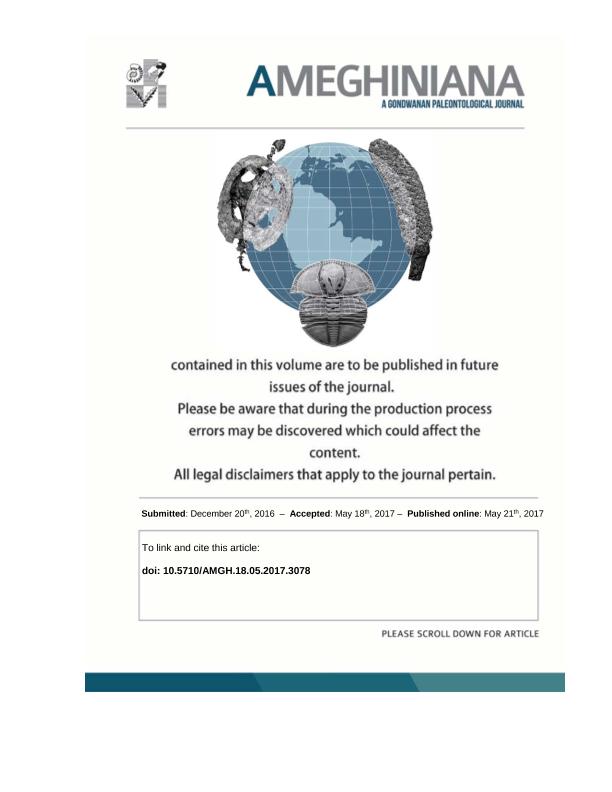Artículo
In this paper new remains of the extinct, mid-sized testudinid Chelonoidis gringorum from northwestern Chubut (Argentina) are described in detail. The specimens were collected in outcrops of the Collón Curá Formation (middle Miocene) and they are represented by postcranial remains mainly carapace and plastron. The taxonomic assignation of these specimens was based on anatomical comparisons with other extant and extinct, mid-sized testudinids from South America. The high intraspecific variation, the lack of a detailed diagnosis of C. gringorum, and the lack of detailed descriptions of extinct mid-sized testudinids from South America in general, made problematic the study of this group. The geographic distribution of the mid-sized testudinids in Argentina during the Miocene shows that there was a displacement towards lower latitudes, which is coincident with the climatic deterioration at the end of the Miocene and that, in turns, had a big impact in Patagonia. Last, but not least, the assignation of these specimens to C. gringorum expands the stratigraphic distribution of this species to the middle Miocene, because before was only known in the early Miocene. En este trabajo se describen en detalle nuevos restos del testudínido extinto de mediana talla Chelonoidis gringorum (Simpson) provenientes del noroeste de Chubut, Argentina. Los especímenes fueron colectados en afloramientos de la Formación Collón Curá (Mioceno medio) y están representados por restos postcraneanos, principalmente caparazón y plastron. La asignación taxonómica de dichos especímenes se realizó mediante comparaciones anatómicas con otros testudínidos de mediana talla, tanto fósiles como actuales de Sudamérica. La gran variabilidad intraespecífica, la falta de una diagnosis detallada de C. gringorum y la falta de descripciones detalladas de testudínidos extintos de mediana talla de Sudamérica hace que el estudio de este grupo sea complejo. La distribución geográfica de los testudínidos de mediana talla durante el Mioceno en Argentina muestra que hubo un desplazamiento hacia latitudes más bajas a lo largo de ese periodo, lo cual es coincidente con el deterioro del clima global acaecido hacia finales del Mioceno y que tuvo un gran impacto en Patagonia. Por último, la asignación de estos especímenes a C. gringorum extiende la distribución temporal de dicha especie al Mioceno medio ya que antes era solo conocida para el Mioceno temprano.
Morphology of the Mid-Sized Tortoises (Testudines: Testudinidae) from the Middle Miocene of Northwestern Chubut (Argentina)
Fecha de publicación:
02/2017
Editorial:
Asociacion Paleontologica Argentina
Revista:
Ameghiniana
ISSN:
0002-7014
e-ISSN:
1851-8044
Idioma:
Inglés
Tipo de recurso:
Artículo publicado
Clasificación temática:
Resumen
Archivos asociados
Licencia
Identificadores
Colecciones
Articulos(CIEMEP)
Articulos de CENTRO DE INVESTIGACION ESQUEL DE MONTAÑA Y ESTEPA PATAGONICA
Articulos de CENTRO DE INVESTIGACION ESQUEL DE MONTAÑA Y ESTEPA PATAGONICA
Articulos(SEDE CENTRAL)
Articulos de SEDE CENTRAL
Articulos de SEDE CENTRAL
Citación
Oriozabala, Carolina; Sterli, Juliana; Gonzalez Ruiz, Laureano Raul; Morphology of the Mid-Sized Tortoises (Testudines: Testudinidae) from the Middle Miocene of Northwestern Chubut (Argentina); Asociacion Paleontologica Argentina; Ameghiniana; 55; 1; 2-2017; 30-54
Compartir
Altmétricas




